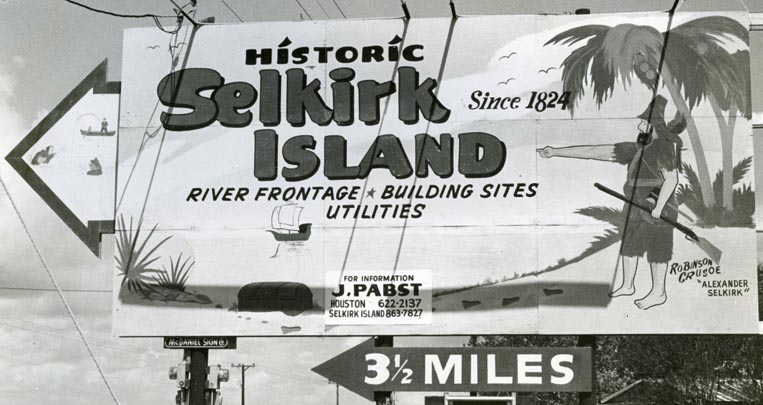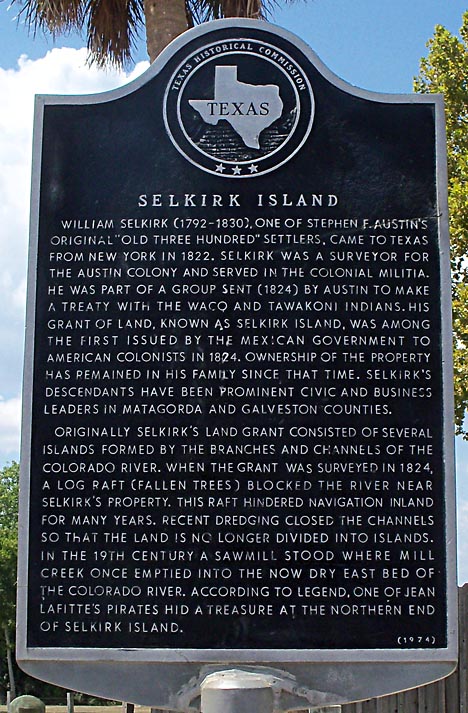|
|
|||||
|
James Henry Selkirk Samuel Gross Selkirk Family
Selkirk Island
For
Kids |
|||||
|
By Mrs. E. T. Pabst Selkirk Island is a resort and permanent-home subdivision on the Colorado River between Bay City and Matagorda . Businesses on the Island include Selkirk Island Corporation (the developers), Selkirk Realty, Selkirk Island Utilities Corporation, and the Property Owner's Association. Ownership of these businesses is vested in J . Pabst, who died March 19, 1984, and Mrs. J. Pabst (E. T. Pabst).In the late 1960's, when thirty acres (which became Exotic Isle) were cut from the Island by the Corps of Engineers in straightening the Colorado River, Colonel Wyatt O. Selkirk and his nephew, J. Pabst, decided to subdivide Selkirk Island itself. Colonel Selkirk passed away in early 1971; therefore, J. Pabst was responsible for developing, selling, and managing Selkirk Island until his death in 1984. The first lots in the subdivision were ready for sale in 1970, and by 1977 approximately 500 lots in the five existing sections were sold. From 1971 to 1984, 150 houses have been built, many of which are permanent homes. These homes on the naturally-wooded waterfront have their own fishing piers. The Colorado River affords both fresh and saltwater fishing and is a haven for waterskiing and for boats of all sizes. With the building of the jetties at the mouth of the Colorado River, these residents can take deep-draft vessels directly into the Gulf of Mexico. The Selkirk name dates back to 1822 when William Selkirk, one of Stephen F. Austin's "Old Three Hundred," came to Matagorda County. Since then the name "Selkirk" has been common in Matagorda County affairs as county clerks, tax assessors, treasurers, postmasters, and developers. Selkirk Island is a historic spot. A stream called Mill Creek once crossed through the island and was the site of an early saw mill. Another bit of interesting history is the story of a Scottish sailor, named Alexander Selkirk, who was shipwrecked on a remote island off the coast of Chile. He spent over four years on the island before he was rescued. After returning to Scotland, his story was told to Daniel DeFoe who used Selkirk's diary as the basis for the classic book, Robinson Crusoe. Years later, in 1822, William Selkirk in his own way, was a "Robinson Crusoe" who braved the wilderness to colonize the land. As one of Stephen F. Austin's surveyors, he drew the first map of Matagorda County. Because of the historical connection between the fictionalized Robinson Crusoe and Alexander Selkirk, the developers of Selkirk Island used Robinson Crusoe's picture as their logo. Selkirk Island is significant for other reasons. The ownership of the Island has been in the family for five generations; the original Mexican land grant was deeded to William Selkirk in 1824. According to family legend, William Selkirk had been given a map by an old sailor, and he joined Stephen F. Austin's colony in order to pursue the buried treasure, supposedly at the site of Selkirk Island. The beauty of the natural environment of this recreational area will be enjoyed by those who live at Selkirk Island now and for many future generations to come. The Island boasts an excellent swimming pool, community boat ramp, and fishing pier as well as a picnic area for property owners who have not yet built their dream home.
Historic Matagorda County,
Volume I, pp. 398-399, 1986 |
|||||
|
|||||
|
The old adage, "History repeats itself," again scores a mark in the story of the Selkirk family, direct descendants of Alexander Selkirk, known the world over as Robinson Crusoe. It was the lure of an island that brought William Selkirk, a prosperous New Yorker, to Matagorda County in the year 1824, where he was given the Spanish headright to three islands, which he named the Selkirk Islands. A few months before, William Selkirk had befriended a sick, outcast sailor whose name, coincidently, was Robinson. At Robinson's death, the grateful mariner gave Selkirk the only thing he had, a map; and told him the story of his life. He had been, he said, a pirate on one of Jean LaFitte's vessels. One day, while sailing in the Gulf of Mexico, the hold of their boat laden with treasure, they found they were being pursued by the Spaniards. They made their way to Matagorda Bay, and aided by a stiff breeze and a high tide, managed to cross a sandbar and get into the mouth of the Colorado River. Robinson and another sailor were put ashore and commanded to bury the chest on the tip of an island there. The next morning the enemy overtook them, destroyed their ship and killed the crew; Robinson alone escaped, the map still in his possession. With difficulty, he made his way back to New York; but the hardships of the trip were too great, and soon after William Selkirk aided him, he died. Found Another Treasure Immediately after the sailor's death, Selkirk set out for Matagorda Bay, and when he had secured his grant to the islands, started his search for the treasure. He called the trip of the largest island, where the chart indicated the treasure to be buried, Gold Point, and so it is known to this day. He did not find the pirates' gold, but it seemed to him he had found another treasure in the islands themselves. Their fascination filled him, and often he found himself dreaming over his pick and shovel. Even at night the mystery of the islands hovered over his slumbers. Who knows, perhaps it was that first Selkirk's dominant wish to be put ashore on the island of Juan Fernandez that stirred again in William Selkirk's heart a century later. At any rate, he decided to go back to New York, get his family, and settle permanently near his islands. He started one night for Galveston, where he intended to visit friends before going on to New York, but he was never seen alive again. Early the next morning, when the first streaks of dawn could be seen on the horizon, while the gulls screamed over a school of fish, and a buzzard made a tiny speck against the gray sky, William Selkirk was found with an Indian arrow through his heart. Some time later, his family, headed by his son, James Henry Selkirk, came to Texas to claim the islands. They made their home in Matagorda, and the islands possessed by them as they had claimed their father before them. In time James married and had a son, Samuel Gross Selkirk. He lives today in Bay City, and at the age of 76 is the oldest living descendant of Alexander Selkirk. Other Selkirks Other members of the immediate family are: Ethel Selkirk Rayne of New Orleans, Luline Selkirk Crofton of Dallas, Adelaide Selkirk Secretan of Houston, Samuel Gross Selkirk, Jr., and his sister, Grace, who live at the Bay City home with their parents and their aunt, Adelaide Selkirk Fisher. James Henry Selkirk, the youngest, follows the sea, just as Robinson Crusoe did, but in a capacity that would have sorely puzzled Crusoe in his day. He is the radio operator on the SS Samuel Q. Brown. He was the radio operator on the SS Henderson when that ship took President Harding on his last voyage, the trip from Alaska to the coast of California. The Crusoe Ranch, owned by the Selkirks, is about midway between Bay City and the islands. Every fall the cattle are driven from the ranch down the banks of the Colorado and made to cross to Wild Cow Island, the largest island. It is the top of this island that is known as Gold Point. Here the cattle spend the winter protected from the cold and the wind by the heavy brush and canebrake. Wild Cow Island has an area of 4030 acres. The next in size is Field Island, about 1000 acres; and the smallest, Dick's Island, about 400 acres. One spring, four calves were overlooked. They remained on the island for four years. One day while hunting, Samuel Selkirk, Jr., caught a glimpse of them. After a struggle, for they had become entirely wild, they were roped and brought to the ranch. They lived only three months; the hot sun on the prairies was too intense after the shadows of the islands. Islands' Fascination This is a brief sketch of the last four generations of the Selkirks. Their lives are like the Colorado that flows around the islands. Fresh and deep; a few shadows from the overhanging brush near the banks; but for the most part, clear sparkling in the warm Texas sun; rippling softly here and there in the breeze; and flowing at last into the Gulf of Mexico and to the great beyond. Like the river too, the islands stand in the center of their lives, with a fascination to them all that can not be answered or explained. Laughingly, the youngest generation refer to themselves as the "heirs to the islands," but there is a seriousness behind it all. I wonder, if, on a moonlight night, when the canebrake rustles with wind from the gulf, two shadows, one a shade darker than the other, could not been seen wandering happily on Wild Cow Island. Perhaps we could even faintly hear the barking of a dog, and if we came along the shore at Gold Point before the water had time to wash away, we might even see the print of a bare human foot in the sand. Author's note: Gold Point is mentioned in "Coronado's Children" by Dobie. A copy of the original Spanish headright can be seen in the state files at Austin.
Palacios Beacon, November 16, 1933 |
|||||
|

